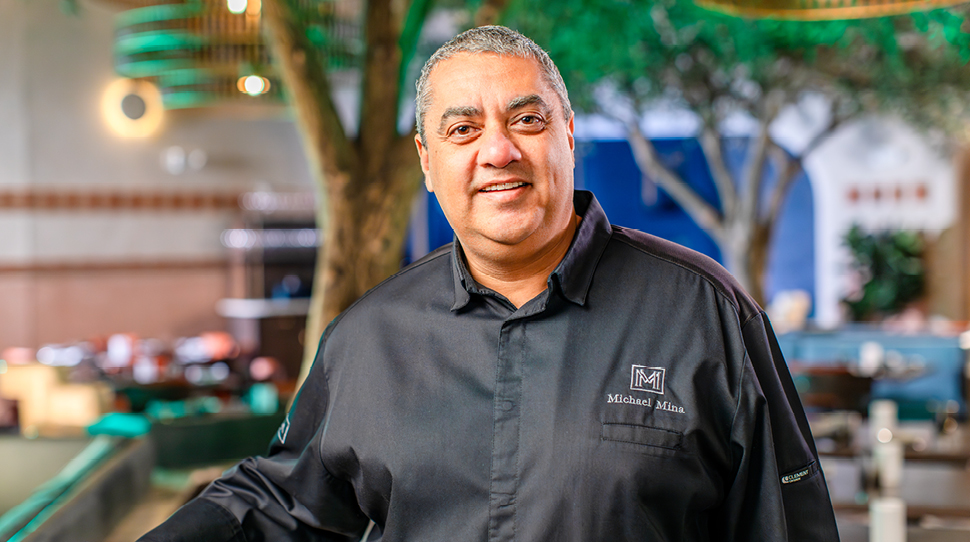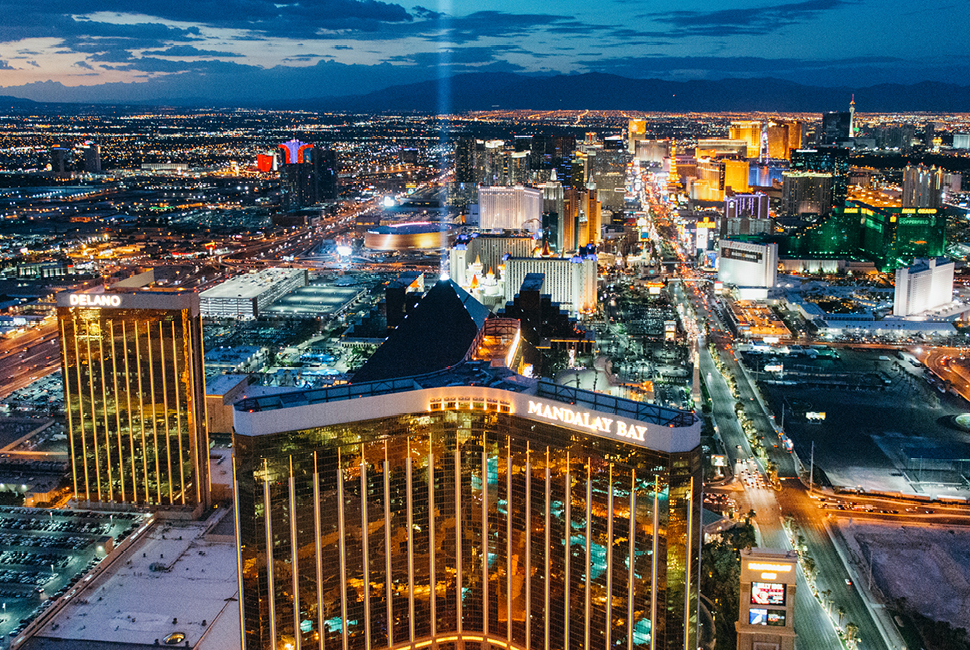

Just when it looked like Las Vegas was about to fully embrace its title as a foodie city, it decides to throw on some sneakers and become a sports hub. But for celebrated chef Michael Mina, it doesn’t matter if the conversation centers around Super Bowls or bowls of ramen—he’s here for it all. As the proprietor of some of the city’s buzziest restaurants (such as Forbes Travel Guide Four-Star Michael Mina, Bourbon Steak and the just-opened Orla), Mina has a soft spot for Sin City’s culinary scene. However, as a long-time San Francisco 49ers fan, he also goes hard for football. But with the new NFL season still five or six months from kicking off, chef Mina has plenty of time to talk to us about his new restaurant, Vegas’ still-evolving dining scene and his favorite vacation spot to huddle up in when he gets a few days away from the kitchen.
Where in the world are you right now?
I am in Las Vegas. I kind of split my time mostly between Vegas and San Francisco. It’s been home for many, many years. It’s funny. Everyone asks me about living in Vegas: What surprised you the most about living there? I thought I would travel more. But you travel less. The reason is because every time you have to have a meeting and you tell them you’re in Vegas, they say, “I want to come to you!”

You just opened Orla at Mandalay Bay a couple months ago. How are things going so far?
It’s amazing. I’ve been extremely blessed to have been able to open many, many restaurants in my career. Let me give you the history on it because it’s that important to me. I’m Egyptian and I decided that I wanted to really do this Egyptian cookbook. My parents are getting a lot older. I was at Michelin-starred restaurant Michael Mina San Francisco [thinking about doing this] at the time. I want to get this done before anything happens to my folks. I said I’m going to play around with this cuisine that I’ve always wanted to do. I’m going to take the roots of what I grew up eating, a lot of the food that my mom made, that my family made [and make a cookbook]. We immigrated when I was two years old. My mom had like seven brothers and sisters that all lived around us. In Middle Eastern households, dinner, especially on the weekends, it’s 30, 40 people. They eat all day. There’s food on the table all day and everything’s kind of centered around the table. So, I took the cuisine and elevated it. It was good timing. Eastern Mediterranean [food is popular]. A lot of great Israeli restaurants have been popping up. I felt like it was a really good time to lean into that and just enjoy it. Take some of what I grew up eating and put great product, good technique and good innovation to it, which is kind of the recipe I try to do with everything.
It was super successful. It was a very upscale experience. Then the pandemic happens. Me and the group decided we’re going to move the majority of the group to Las Vegas and be based out of Las Vegas. I’ve always looked at it like, “If I ever get an opportunity to open this style of restaurant, I want it to be in the city where I’m spending the most time.” Then I got this amazing opportunity with Mandalay Bay, where they asked me to do a Mediterranean restaurant.

You mentioned the pandemic. That’s on top of the day-to-day rigors of running a restaurant. What keeps you coming back for more?
There are multiple reasons. I will say this, and I believe this from the bottom of my heart, you either have never worked a day in your life if you’re in the restaurant business, or it’s completely a job. It really depends on the personality of the person. One lives to eat and some people eat to live. There’s people where food is just fuel for them, right? And then there’s people that wake up in the morning and think about what they’re about to eat. I fall into that [latter] category. Number two, it’s hospitality. Once it’s in your genes [it’s there forever]. From the day I started working in a restaurant, it was in me. I loved serving. I loved that excitement in the dining room and in the kitchen.
And then I played a lot of sports, believe it or not, many pounds ago. Having a restaurant is a lot like sports. I was really good at basketball. I wasn’t as good at football, but I played both. I raced raced motocross for a long time. [The restaurant business] is a lot like sports. It challenges everything. It’s emotionally challenging. It’s physically challenging. It’s mentally challenging. And then it’s creatively challenging. When you put all that together, that creates something you’re going to love to do or hate to do. You’re either built that way and you love having all of those things going on all the time or it’ll absolutely drive you nuts. For me, I’m the first. I really love the team aspect of what a restaurant is all about.
You have restaurants all over the country. Though menus are different, what’s a common thread between them?
Each restaurant, you’re going to start with a concept. And from that concept, you want to bring that concept and vision to life. My style of cooking comes from my childhood, because when you eat Middle Eastern food, you’re going to get very bold food. When I think about bold and putting together a dish, it’s all about balance. If you think of your palate, you’re tasting acid, you taste sweetness, you taste spice and richness or fat. The best way for me to describe this to you is a vinaigrette, right? A vinaigrette is going to have oil and lemon juice. If it’s got too much oil and not enough lemon juice, the salad would be bland and boring. If it’s got too much lemon juice and not enough oil, the greens taste bitter.
A more dynamic dish would be a honey mustard vinaigrette. You had acid and you had fat already. Then you add honey. You’ve added sweetness and then you’re adding mustard, which is spice. Magic starts to happen with food when you balance all of those things. When you have a 10-course tasting menu or a 17-course tasting menu, that’s a layup. That’s an absolute layup. I gotta excite you for two bites and then I move on. If I just pick the right China and do all of the right things, I almost get a hall pass. But giving you an entrée, where you’ve got to eat 40 bites and you don’t want to put down your fork, now that’s hard. That’s where balance comes in.

How has the Vegas diner changed over the years?
I’ll tell you what. One of my absolute favorite places to cook is Vegas. And it’s organic. I want to take you all the way back to when I started 25 years ago here with Bellagio. It has changed a lot since then. One of the challenges at the beginning, people were concerned about [hiring qualified] staff. One thing I found out really quickly was that, even though there weren’t restaurants of [top] caliber like there are now in Vegas, there was hospitality. People had already been serving. Maybe it was at Rainforest Cafe. Who knows? They were already serving seven or eight tables. They already had the hospitality gene. You just had to teach them these new products.
And the customer wanted to eat really quick because they wanted to gamble. You had to be ready for that. But the biggest thing that you see now is that once they decided this was going to really become a food destination, it became one really quick. There was already a clientele here wanting it, whether it was people that lived here, a lot of transients and a lot of group business. It became a show. As a restaurateur, now I see how many other restaurateurs will come here. If Vegas is not number one, it’s top three cities if you’re thinking about building a steakhouse or building any type of restaurant. You come to Vegas so you can see all the different restaurants. The casinos are all like little cities.
Do you and International Smoke partner Ayesha Curry have any more magic planned together in the future?
God willing, I’ll be connected with them for the rest of my life. They’re just amazing people. We will do more things together. They are exactly who you want them to be. And more so. There’s nothing there that isn’t real, man. Those are good people.
When you have a day to yourself, what do you do for fun around Vegas?
We moved out to a spot where I literally can go out my gate on either my quad or my two-wheeler and drive right up to the desert and then just go ride. I would say that’s always the go-to. Obviously, family. We do a lot with them.
Wait, you go off-roading?
Yes, you can ride right up to the desert. They put trails on the side of the road where you can ride. You don’t even have to load up your motorbike. You literally can go out your gate ride, ride straight up to the desert and then go ride.

If you want to leave the desert for a few days, where are you going to relax?
“Relax” is always Hawaii for me. That’s it’s always. And I’m kind of a creature of habit because I find something that’s absolutely perfect for me [and I keep going back]. It’s Kailua. That’s where I always go. I don’t want to make a mistake and go to the wrong place.
We also do food trips. Me and the team, we always do food trips at least one a year, sometimes two a year. Those are different. Those are much more strategically thought out. Those are all around food. They’re completely based around what we want to see, taste, learn about okay.
Where are you going for this year’s food trip?
This year we’re going to probably do Peru. We’re going to go through South America. We haven’t done that. We’ve teased it. We’ve done Colombia, but we haven’t done a full food trip this year. We’re going to do that one.
